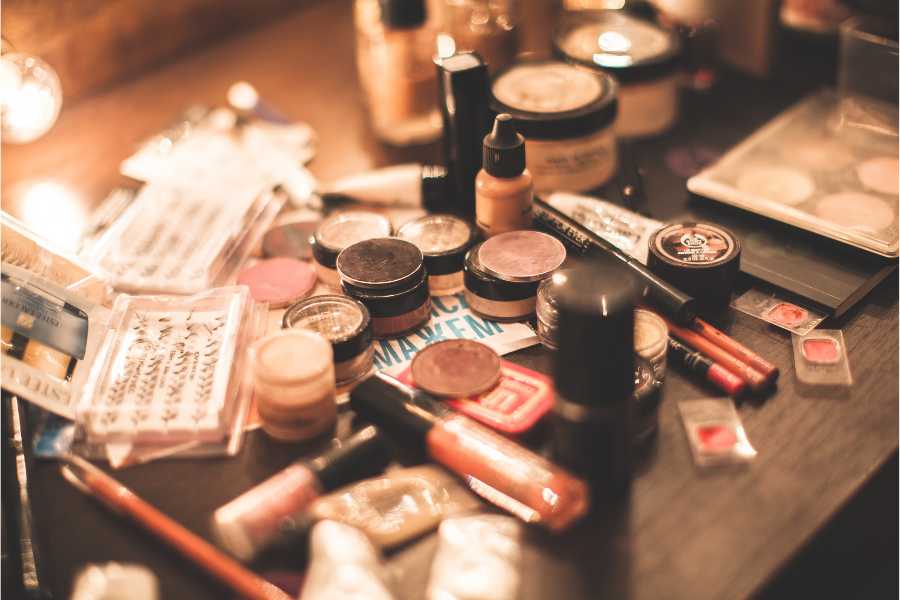The Invisible Chemistry Beneath Your Skincare Routine
Most modern cosmetics look clean, elegant, and harmless — but many are built on petrochemical and synthetic compounds that behave very differently from natural substances. What you apply to your skin doesn’t stay on the surface; it can be absorbed, stored, and even alter your hormonal and metabolic balance.
In my clinic, I often meet women struggling with hormonal imbalance, infertility, or unexplained fatigue — and many have unknowingly exposed themselves daily to compounds that disturb endocrine, mitochondrial, and immune function.
Let’s examine what’s hiding inside the jar.
1. Endocrine Disruptors — Hormone Imposters in Everyday Products
Endocrine disruptors are chemicals that mimic, block, or distort natural hormones such as oestrogen, progesterone, testosterone, and thyroid hormones. Even tiny doses can create long-term biological changes.
Common examples include:
| Ingredient | Where It Appears | Why It Matters |
|---|---|---|
| Oxybenzone (Benzophenone-3) | Sunscreens, lip balms | Oestrogen mimic; interferes with thyroid and reproductive hormones. Detected in blood and breast milk. |
| Octinoxate, Avobenzone, Homosalate | Sunscreens, tinted moisturisers | Weak oestrogenic and anti-androgenic effects; degrade to benzene derivatives under UV exposure. |
| Parabens (methyl-, propyl-, butyl-) | Lotions, makeup, deodorants | Accumulate in breast tissue; mimic oestrogen activity. |
| Phthalates (often hidden under “fragrance”) | Perfume, nail polish, hair spray | Suppress testosterone, disrupt foetal development. |
| Triclosan / Triclocarban | Antibacterial soaps, toothpaste | Alters thyroid signalling and microbiome balance. |
Long-term exposure contributes to menstrual irregularity, thyroid dysfunction, metabolic slowing, and lower fertility in both men and women.
2. Nanoparticles and Penetration Enhancers — Microscopic Gate-Crashers
To improve texture or UV protection, many formulas now use nanoparticles (e.g., nano-zinc oxide, nano-titanium dioxide). These ultra-small particles can enter hair follicles or wounds and generate reactive oxygen species (ROS), leading to oxidative stress or DNA damage.
Similarly, propylene glycol, PEGs, and ethanolamines (DEA, TEA, MEA) are used to help ingredients “sink in.” They do this by loosening the skin barrier, but that also allows toxins to reach systemic circulation. These same solvents are derived from industrial antifreeze and lubricants.
3. The Hydrocarbon Foundation of Modern Cosmetics
The base of many creams, balms, and cleansers isn’t botanical oil — it’s refined petroleum. Ingredients such as mineral oil, paraffin, petrolatum, isohexadecane, dimethicone, and polyisobutene come from the same crude oil used to make fuel and plastics.
Why that matters:
a. Occlusion and barrier suppression
Petrochemical emollients form an impermeable film that traps moisture but also blocks natural gas exchange and sebum flow. Over time, the skin loses its ability to self-regulate hydration and oxygenation.
b. Bioaccumulation
Mineral oil hydrocarbons can penetrate the skin and have been detected in adipose tissue, lymph nodes, and even breast milk. Lipophilic compounds persist for years.
c. Mitochondrial interference
By altering lipid membranes and limiting oxygen diffusion, hydrocarbons push cells toward anaerobic (low-oxygen) metabolism, reducing energy output and increasing inflammation — exactly what accelerates skin ageing and hormonal imbalance.
d. Synergy with other toxins
Solvents such as propylene glycol enhance absorption of preservatives, UV filters, and fragrances. This converts a trace exposure into a systemic load, especially with daily use.
e. Aryl hydrocarbon receptor (AhR) activation
Many aromatic hydrocarbons (benzene-ring structures) activate the AhR pathway, which regulates detox enzymes and steroid metabolism. Chronic stimulation of AhR is linked to endocrine disruption, autoimmune activation, and carcinogenesis.
4. Preservatives, Fragrances, and Colourants — Hidden Chemical Cocktails
Even “clean” products often rely on problematic substitutes:
-
Phenoxyethanol — widely used in “paraben-free” formulas, but can cause nervous-system toxicity in infants.
-
Formaldehyde-releasing preservatives (DMDM hydantoin, quaternium-15) — classified as human carcinogens.
-
Methylisothiazolinone (MI/MCI) — potent allergen and neurotoxic in lab models.
-
Synthetic fragrances (“parfum”) — mixtures of hundreds of undisclosed chemicals, frequently containing phthalates and solvents.
-
Coal-tar dyes (FD&C colours) — may include heavy-metal impurities or benzene-derived molecules.
In the UK and EU, concentrations are limited, but mixture effects — low doses from dozens of products — remain largely untested.
What This Means for Hormones, Fertility, and Energy
The skin is a living endocrine organ. It produces and responds to steroid hormones and communicates with the hypothalamic-pituitary-adrenal (HPA) axis. When petrochemicals, endocrine disruptors, or nanoparticle carriers interfere, the result is systemic — not just cosmetic.
Consequences may include:
-
Impaired steroidogenesis (progesterone, testosterone, cortisol imbalance)
-
Reduced mitochondrial energy output and increased oxidative stress
-
Subclinical thyroid disruption
-
Chronic low-grade inflammation
-
Altered skin and gut microbiome composition
For individuals seeking fertility, hormonal balance, or graceful ageing, such exposures are far from trivial.
Building a Safer Skincare Routine
Prefer formulations based on:
-
Cold-pressed plant oils that are stable (jojoba, olive, squalane from olives)
-
Beeswax, shea butter, lanolin, tallow for barrier protection and nourishment
-
Natural humectants like glycerine, honey, or aloe vera
-
Non-nano zinc oxide for UV defence
-
Essential oils used in minute, disclosed amounts rather than “fragrance” blends
Avoid:
-
Mineral oil, paraffin, petrolatum
-
Propylene glycol, PEGs, polysorbates
-
Dimethicone or isohexadecane bases
-
Anything listing “fragrance/parfum” without ingredient disclosure
Choose glass packaging when possible to avoid plastic leaching, and remember that “dermatologist approved” doesn’t guarantee physiological safety.
The Takeaway
What you put on your skin communicates with your endocrine, immune, and mitochondrial systems.
Modern cosmetics often disguise industrial petrochemicals as beauty aids — yet these substances can silently undermine the very vitality, hormonal balance, and fertility that true health depends on.
In my clinical view, caring for your skin should support energy metabolism, not suppress it.
The next time you reach for a cream or sunscreen, read the label as carefully as you would read a food label — your skin is not a barrier, but an intelligent, breathing organ.
More articles by Dr Ryu





